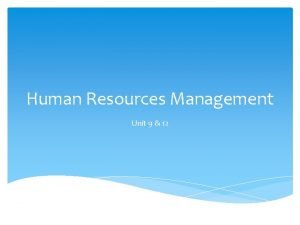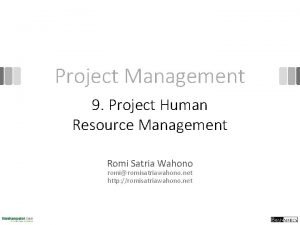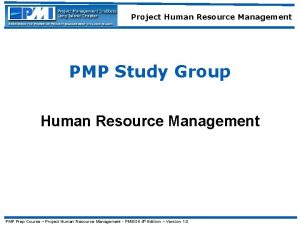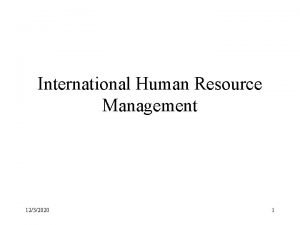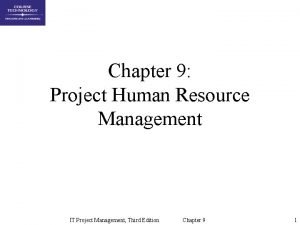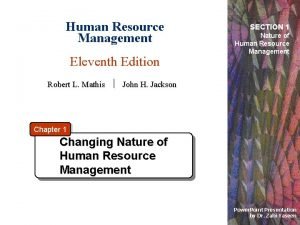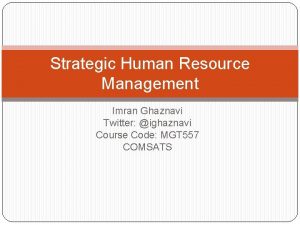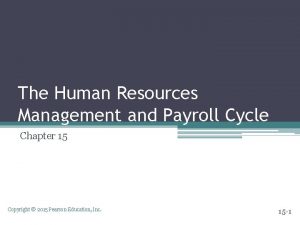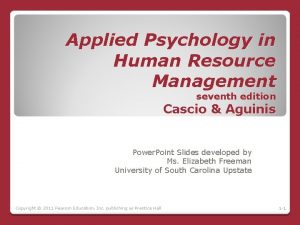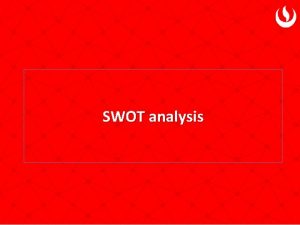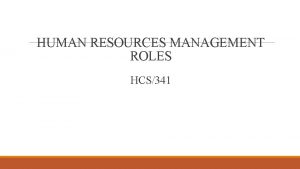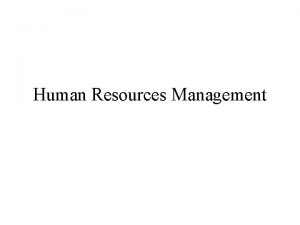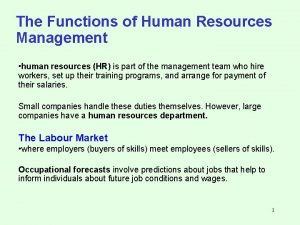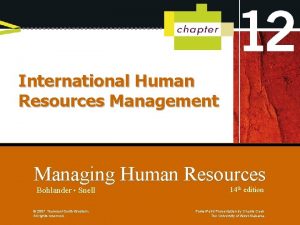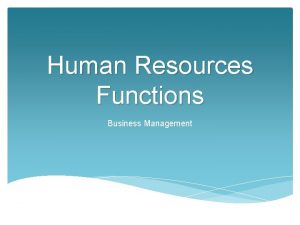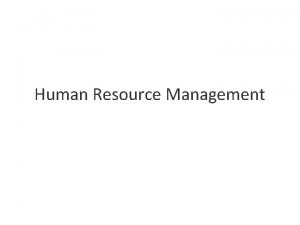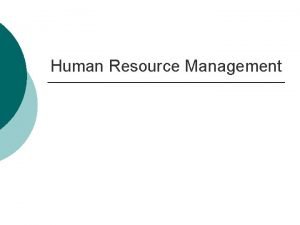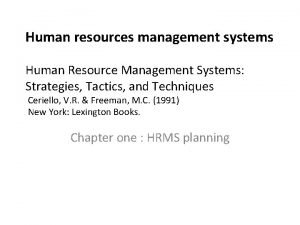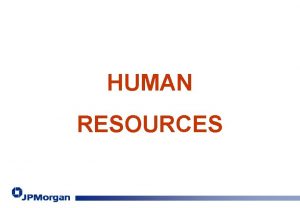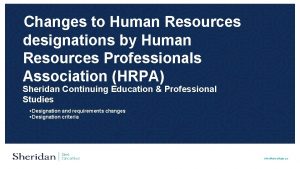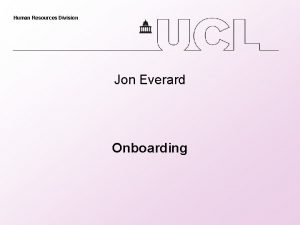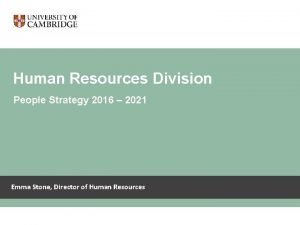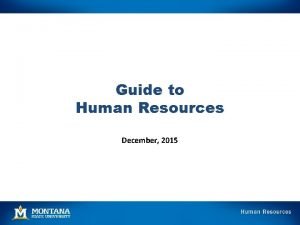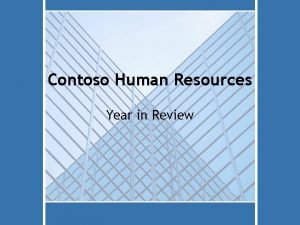Human Resources Management Unit 9 12 Learning Outcomes























![References Inc. com. (2017). Training and Development. [online] Available at: http: //www. inc. com/encyclopedia/training-anddevelopment. References Inc. com. (2017). Training and Development. [online] Available at: http: //www. inc. com/encyclopedia/training-anddevelopment.](https://slidetodoc.com/presentation_image_h/10ec605d18f8bd269936606d6a121825/image-24.jpg)
- Slides: 24

Human Resources Management Unit 9 & 12

Learning Outcomes Unit 9: Understand training & development in services industries businesses Unit 12: Understand company employment policy and standards

Assessment Criteria Unit 9: AC 4. 1 – Assess the contribution of training and development activities to the effective operation of a selected service industry business Unit 12: D 2 – Design an audit system that would allow an HR manager to ensure that both legislation and company standards are being met

Unit 12 HR Audit System

What is a HR Audit? A Human Resources Audit is a comprehensive method (or means) to review current human resources policies, procedures, documentation and systems to identify needs for improvement and enhancement of the HR function as well as to assess compliance with ever-changing rules and regulations. (Hittinger, 2017)

ü How could an audit system assist the HR in an Aviation industry business? v. How does compliance with legislation and company standards helps protect staff & customers?

What does an HR Audit covers? Hiring and Onboarding Benefits & Compensation Performance evaluation process Termination process and exit interviews Job descriptions Form review Safety management system Personnel file review Training records

Sample HR Audit Checklist Simple: http: //www. ayni. ca/sites/default/files/HR%20 Audit%20 Checklist. pdf In-depth: http: //www. ayni. ca/sites/default/files/HR%20 Audit%20 Checklist. pdf

Unit 9 Training & Development

The quality of employees and their development through training and education are major factors in determining longterm profitability of a small business. If you hire and keep good employees, it is good policy to invest in the development of their skills, so they can increase their productivity. Training often is considered for new employees only. This is a mistake because ongoing training for current employees helps them adjust to rapidly changing job requirements.

Training & Development (T&D) The official and ongoing educational activities within an organization designed to enhance the fulfillment and performance of employees. (Business. Dictionary. com, 2017) Training and development describes the formal, ongoing efforts that are made within organizations to improve the performance and self-fulfillment of their employees through a variety of educational methods and programs.

Purpose of T&D Reasons for emphasizing the growth and development of personnel include: Creating a pool of readily available and adequate replacements for personnel who may leave or move up in the organization. Enhancing the company's ability to adopt and use advances in technology because of a sufficiently knowledgeable staff. Building a more efficient, effective and highly motivated team, which enhances the company's competitive position and improves employee morale. Ensuring adequate human resources for expansion into new programs. (Bizmove. com, 2017)

Benefits of T&D Increased productivity. Reduced employee turnover. Increased efficiency resulting in financial gains. Decreased need for supervision.

Barriers & Attitudes to Training Attitude – we’ve always done it that way. Can’t share information – knowledge is power. No link to the mission, vision, and values. Risky because they’re afraid to admit they don’t know. Level of, or lack of, commitment. Reluctant to train others because you might lose your job. No perceived value. Poorly qualified trainers – they do everything. Why train and invest in short -term employees. Time and staffing Budgets No management support

Types of Training Induction/Orientation Training Safety Training Job training Refreshers Training Employee Development Training

Training Methods Off-the-Job On-the-Job Job rotation Cross-training Coaching Mentorship Internship Apprenticeship Classroom/Lecture Online Conferences Courses Vestibule Training Simulation Exercise

Developing a Training Program

Training Needs Analysis -Systematic approach to determine what training needs to take place: Organisational goals and strategies Use of appraisals Self assessments Interviews Customer feedback Tests

Kirkpatrick’s four level of evaluation Level 4: Results Level 3: Behaviour Level 2: Learning Level 1: Reaction

Measuring effectiveness of Training Skills attainment: Measure the learner’s level of knowledge or skill pre-learning and again post learning. Have the learner’s knowledge and skill to perform a task improved? Workplace application: Is there evidence of the learner applying the newly learned skill or knowledge in the workplace. Individual behaviour change: Have the learner’s behaviours in the workplace changed to reflect the corporate culture and goals.

Measuring effectiveness of Training Team behavioural change: Is the team working more coherently, more effectively post learning. Meeting goals or targets: Record the individual/team performance against goals or targets and measure again 3, 6 or 9 months post learning to monitor the impact of the learning.


References Bizmove. com. (2017). Employee Training and Development Process In HRM | Training Methods for Employees. [online] Available at: http: //www. bizmove. com/personnel/m 4 d. htm [Accessed 20 Mar. 2017]. Hittinger, J. (2017). HR Audit - strategic HR, inc. . [online] strategic HR, inc. Available at: http: //strategichrinc. com/services/company-hr-strategy/hraudit-recruitment-analysis/ [Accessed 19 Mar. 2017]. Faa. gov. (2017). Safety Management System (SMS). [online] Available at: https: //www. faa. gov/about/initiatives/sms/ [Accessed 19 Mar. 2017].
![References Inc com 2017 Training and Development online Available at http www inc comencyclopediatraininganddevelopment References Inc. com. (2017). Training and Development. [online] Available at: http: //www. inc. com/encyclopedia/training-anddevelopment.](https://slidetodoc.com/presentation_image_h/10ec605d18f8bd269936606d6a121825/image-24.jpg)
References Inc. com. (2017). Training and Development. [online] Available at: http: //www. inc. com/encyclopedia/training-anddevelopment. html [Accessed 20 Mar. 2017]. Business. Dictionary. com. (2017). What is training and development? definition and meaning. [online] Available at: http: //www. businessdictionary. com/definition/trainin g-and-development. html [Accessed 20 Mar. 2017].
 Human resources learning outcomes
Human resources learning outcomes Resource histogram vs responsibility assignment matrix
Resource histogram vs responsibility assignment matrix Pmp roles and responsibilities
Pmp roles and responsibilities Human resources and job design in operations management
Human resources and job design in operations management Importanceof hrm
Importanceof hrm Empower human resources management
Empower human resources management Meaning of human resource management
Meaning of human resource management Chapter 9 human resources management
Chapter 9 human resources management Human resource management exam questions and answers
Human resource management exam questions and answers Retail organization and human resource management
Retail organization and human resource management Intro to human resource management
Intro to human resource management Weiterbildung human resources management
Weiterbildung human resources management Human resource management gaining a competitive advantage
Human resource management gaining a competitive advantage Chapter 9 human resources management
Chapter 9 human resources management Nature of personnel management
Nature of personnel management Time management human resources
Time management human resources Human resource management concept
Human resource management concept Advantages of external recruitment
Advantages of external recruitment The human resources management and payroll cycle
The human resources management and payroll cycle Applied psychology in human resource management
Applied psychology in human resource management Learning outcomes examples english
Learning outcomes examples english Water cycle learning outcomes
Water cycle learning outcomes Notice writing learning outcomes
Notice writing learning outcomes Objective of swot analysis
Objective of swot analysis Learning outcomes of rhymes
Learning outcomes of rhymes
